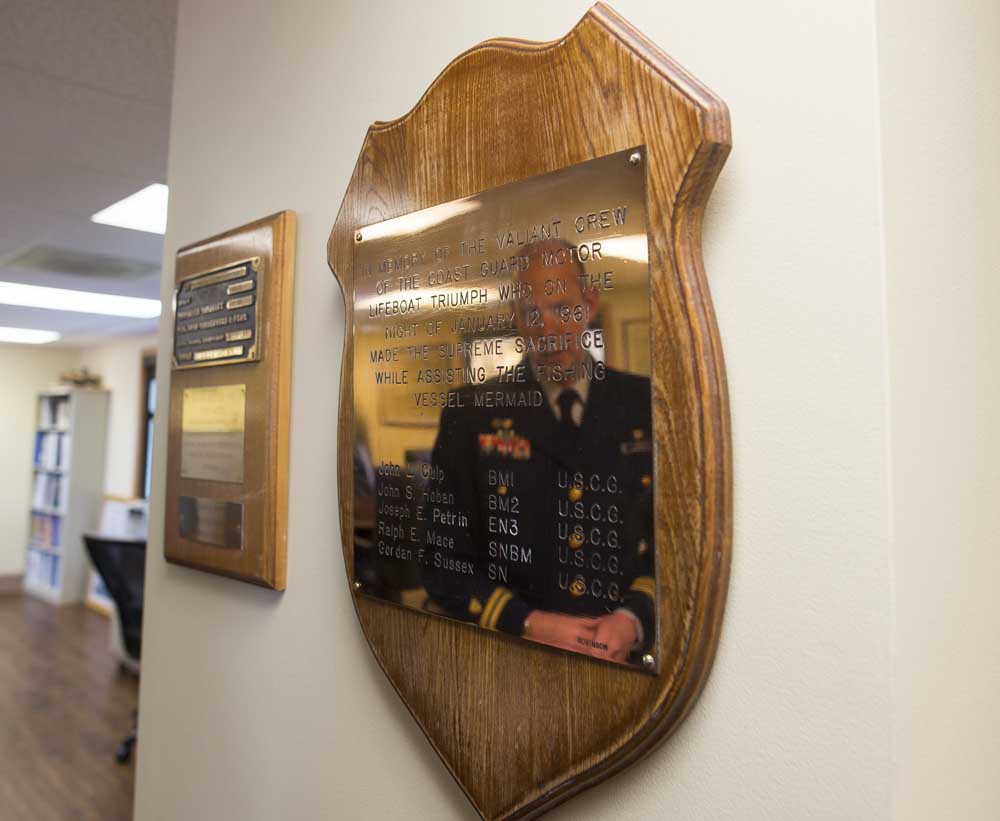A Hollywood ending for daring surfmen
Published 5:16 am Monday, February 1, 2016

- Lt. Tom Condit's reflection is seen in a plaque honoring the crew of the Coast Guard motor lifeboat Triumph.
LONG BEACH, Wash. — U.S. Coast Guardsmen traveled en masse to theaters over the weekend to see “The Finest Hours,” the Disney thriller about one of the service’s most famous rescues at sea.
What some senior surfmen from Station Cape Disappointmentsaw was an homage to one of the greatest operations in Coast Guard history, a bit of drama and a reminder of how far their lifesaving technology has come.
The movie recounted the rescue of 32 of 33 mariners trapped aboard the stern section of the SS Pendleton, an oil tanker split in two by rough seas and run aground on a shoal. The rescue crew, coxswain Bernard Webber and three other Coast Guardsmen from Chatham, Massachusetts, was awarded the Gold Lifesaving Medal, one of the highest honors in the Coast Guard.
“It’s good to see our heritage,” said Chief Warrant Officer Jeremiah Wolf, a surfman trainer at the National Motor Lifeboat School in Ilwaco, the only such school in the U.S. “It made me proud to be a surfman, and proud to be doing what I’m doing today at the motor lifeboat school, training future surfmen, training people to do what Bernie Webber did.”
Surfmen, the elite coxswains who crew lifeboats and provide rescues and other assistance on the water, originated with the U.S. Life Saving Service, which merged with the Revenue Cutter Service in 1915 to become the Coast Guard.
Today’s surfmen can go through up to six years of training to earn their insignia. The school at Cape Disappointment teaches them how to handle the 47-foot motor lifeboat in rough weather. The school’s first and likely only class of the year includes nine operators from troublesome bars around the country who will soon finish up their monthlong training.
Lt. Tom Condit recently replaced Lt. Scott McGrew as commander of Station Cape Disappointment, the largest search and rescue station on the Pacific Northwest coast, covering 50 nautical miles from the entrance to the Columbia River.
“It certainly was entertaining,” Condit said of the movie, which he said depicted an extraordinary situation, with two tankers breaking in two on the same night and the Coast Guard rescuing 70 people.
Condit said the rescue, made amid 60-foot seas and 70-knot (80 mph) winds, probably would have been made with a helicopter today.
The unofficial Coast Guard motto, uttered in the movie, is, “You have to go out, but you don’t have to come back.” The motto stretches back to the regulations of the Life Saving Service, but Condit said the pervasive attitude has changed to one of risk mitigation as technology has advanced.
“You have to keep the crew together, you have to keep our boat together, before we’re able to rescue anybody else,” Wolf said. “We take great care, because we want to be able to effect rescues, and not have to be rescued ourselves.”
More than 100 years ago, 16 rescuers from two lifeboat crews on either side of the Columbia River were awarded the Gold Lifesaving Medal after battling gale-force winds and monstrous seas and losing their vessels during a daring rescue of the crew of the grounded steamer Rosecrans.
The Rosecrans grounded on Peacock Spit, a shoal at the entrance to the Columbia, on Jan. 7, 1913. After grounding, the ship made three or four S.O.S calls, before the captain ordered them halted, fearful sparks would start a fire on board. The Rosecrans did not blow its whistle, either, and it took several hours for rescuers to find the ship in the bad weather.
Of the 36 crew members on board, 33 died. Two were rescued from the steamer’s rigging by the lifeboat Dreadnaught from the Point Adams Lifesaving crew several hours after the stranding. The final survivor drifted ashore on a plank. Oscar S. Wicklund, one of the rescuers from Point Adams, said most of the crew could have been saved, had the Rosecrans been found earlier.
The lifeboats Dreadnaught and the Tenacious from Cape Disappointment, with help from tugs, battled the strong winds and high waves trying to locate and rescue the remaining crew from the Rosecrans.
The Tenacious was eventually capsized, its hull cracked and steering disabled. The Dreadnaught towed the Tenacious to the nearby tugboat Fearless, before returning to the wreck of the Rosecrans to rescue two crew members still clinging to the rigging. The crew rescued a third, who later died from a severe concussion.
Both the Tenacious, being towed across the bar by the tug Fearless, and the Dreadnaught, tethered to the lightship Columbia after its crew was brought on board, were destroyed in the Graveyard of the Pacific.





